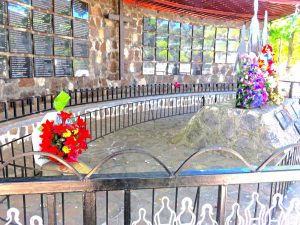On this page: Communist Collectivity here ♦ Uses and Limits of RJ here ♦ El Salvador RJ means fascists go unpunished here ♦

Morazan, El Salvador: memorial for victims of El Mozote massacre
Communist Collectivity Will End Capitalist Punishment
Capitalism’s system of punishment leaves everyone sick: victims, perpetrators, and communities. When a person commits a “crime,” they end up in a cell isolated from their community with very little stimulation. Prisoners live in chronic high stress and fear. Not surprisingly, when released they are likely to re-offend and return to prison. In Colorado’s diversion program they practice Restorative Justice and have an 8% recidivism rate, significantly lower than overall recidivism of US prisons. But this still does not resolve capitalism’s essential contradictions.
The practice of punishment has been inherent in capitalism’s wage slavery from the start. The biggest crime is the capitalists’ theft of the value workers produce every day. But the bosses use punishment to control us, the masses. It may even feel natural. Like racism, it informs most institutions, including schooling and work. Children are socialized early to fear punishment. This causes alienation from one another and from our caretakers in families. In our schools it causes alienation between teachers and students.
When harm happens, we ask who is to blame and how should we punish them instead of why there was harm and how we can repair and prevent it. Instead of focusing on making our communities whole and repairing harm, capitalism focuses on punishing perpetrators and scaring people into not becoming perpetrators.
Capitalists have no real investment in developing individuals, as long as they have obedient workers. Capitalists treat us as commodities—both usable and dispensable. They try to hide how we are all interconnected because capitalism must keep us divided.
Many develop anxiety, depression and are left angry and resentful. Capitalism thrives on and values selfishness, individualism, competition, racism, sexism. The ruling class then finds reasons to lock up minorities and the poor while producing constant high stress, inside and outside the prison system.
However, the foundations of moral behavior are inborn. We have mirror neurons present from birth that help us grow empathy and shape our behavior, despite being born into capitalism. The key ingredients that reduce chronic stress are compassion, connection to others, and caring for others. The practice of giving rather than receiving helps humans reduce stress and promotes longevity. It allows humans to flourish.
The long-term fight for communism requires us to change. Communist collectives struggle to put the needs of the masses and of the collective first. Communists care about and struggle with each other to be less selfish, to do away with racist and sexist ideas and practices. We struggle to work together for our common goal: to get rid of capitalism and its prisons and build a society based on communist relations to meet everyone’s needs.
In communism, people will not be put in cages with limited contact with their communities. We can use the methods of Restorative Justice to correct behavior. This helps both the victims and perpetrators heal. A safe face-to-face contact is facilitated among all affected. Victim, perpetrator, and members of the community come together. The victim can air their pain and talk about the consequence of the perpetrator’s action(s). The perpetrator can see the impact and emotional response, stimulating their amygdala, which helps them grow in empathy, accountability, and remorse. They can apologize sincerely and become open to making amends. Victims become more able to forgive, releasing anti-inflammatory agents into the body. Healing becomes possible. Together all participants come up with what the amends will look like. New brain cells and connections are possible. We will bring science to recovery. No one will be dispensable.
The masses seizing the means of production through revolution and organizing communist relations of production will mean a healthy society. However, if we hold onto cultural beliefs like blaming, shaming, and punishment, our revolutionary project will fail. It’s important that we begin now to practice changing our thinking and practices. We try to do this in communist collectives. How can we do better at this in our collectives, and also in our families, and at school and work?
Of course, when there are diametrically opposed interests like between workers and bosses, it is not possible to resolve the conflicts in a restorative manner. However, when we are working together with our working-class siblings, we should practice and improve resolving conflicts this way.
A communist system will produce what everyone needs, as opposed to maximizing profits. We will repair harm rather than producing more harm. A restorative justice process would work to make the community whole again and let each of the people involved know that they are valuable members of the community despite past behavior.
Uses and Limitations of “Restorative Justice”
Restorative justice or restorative practices can be useful in building and maintaining community and in helping to imagine a world without punishment, but they have their limits.
Restorative practices are useful in challenging the punishment model that pushes so many working-class children out of schools. The practices can be used to build community and resolve conflicts among people that should be in community, but often are not because of artificial divisions created by capitalism.
For example, rival groups of students come into conflict with one another based on an illusion of ownership of one neighborhood or another (gangs). Instead of using punishment to exclude the students from the school, a restorative model can be used. It asks what harm has been caused, both to the individuals involved and to the community. When the students sit in circle with each other, they can sometimes see the bonds that unite them and dispel the illusions that divide them.
However, restorative justice has its limits. It cannot be used to resolve class conflicts. Working class people do not have the same interests as the police, so we cannot work to resolve conflicts with them restoratively.
The police are our class enemy, just as the bosses are. Workers cannot sit in circle with the factory owner because the factory owner’s existence is based on the exploitation of the workers. The resolution of this contradiction requires a communist revolution, the abolition of the wage system and collective communist production
So restorative justice is useful within communities and helps us to resolve conflicts where we do harm to one another. But we cannot allow for it to be co-opted and used by capitalists to try to get us to believe that we can resolve the contradictions of capitalism, racism, sexism and homophobia, by talking it out.
Restorative justice cannot exist between people who are not in community, who do not hold the same class interests.
—Seattle High School teacher
“Restorative Justice” in El Salvador: Fascist Murderers Go Unpunished
During the civil war in El Salvador, there were many massacres, tortures and disappearances of the civilian population and people who had organized against government repression. These brutal attacks were carried out by the military and security forces in different areas.
One of them was the massacre of El Mozote and nearby places in the department of Morazán in 1981. Approximately 1000 people were murdered there in the most cruel and ruthless way. They included women, men, children, the elderly, rural workers killed at the hands of units of the Atlacatl Battalion of the Armed Forces (formed by the CIA at the School of the Americas in Panama).
This massacre is considered one of the vilest ever committed against the defenseless civilian population. It was repeatedly denied by government authorities. To this day there has been no sign of justice. Some governments have promised to carry out justice but have done the opposite. They have prevented any type of investigation into this massacre.
Some journalists reported in national and international newspapers on the barbarity that was committed. They were called liars. The White House not only denied the facts, but also increased the economic budget to the Salvadoran government to attack the guerrillas.
A 1993 “Amnesty Law” shielded the perpetrators from prosecution. Later, when it was abolished (in 2016), they began to speak of “Restorative Justice.” This is a type of justice in which there is no punishment. It is about forgiving and forgetting. An experiment of letting the victims speak.
Maybe it is better psychologically to bring the cases to light; it brings some relief. But the murderers remain unpunished. Maybe restorative justice is a way of not doing justice.
In 2019, the 11th Restorative Justice Tribunal was held in El Salvador. It is not criminal court justice, but rather it is defined as “moral justice.” It is a space that serves the victims to prepare themselves in case justice is ever done, in multiple cases of murders and massacres of workers that occurred in the country.
The victims are still waiting for justice, but that will only happen in a classless society, where the causes that motivated them to organize, for which they were massacred, will not exist. We are talking about a Communist society.
—Veteran Comrades in El Salvador


